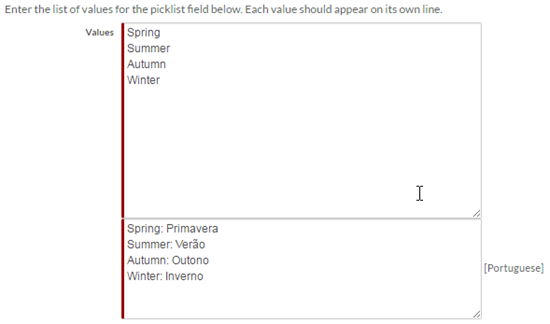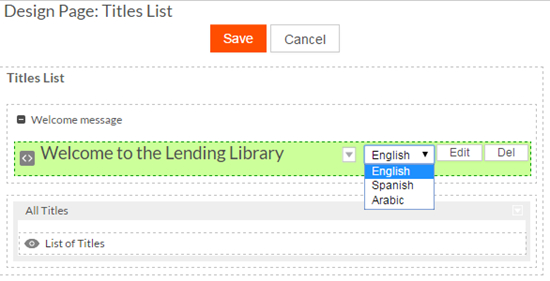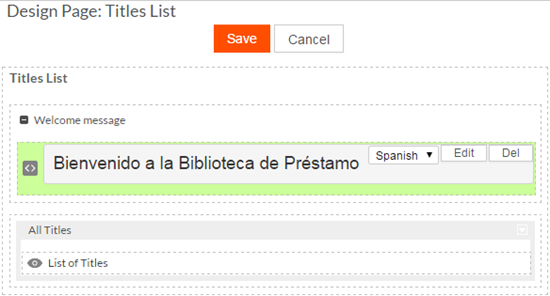Translating application component names and labels
You can translate individual application component names and labels for an existing application or you can translate component names and labels when creating them. The following table contains the types of application components, what you can translate for each component, and where to translate each type of component.
| Component | What you can translate | Where to translate |
|---|---|---|
| Application | Application Name, Description | New Application screen or Edit Application screen. See Creating and managing applications. Note that the Quick Create wizard does not provide fields for translating new components. |
| Tab | Tab Name, Description | New Tab screen or Edit Tab screen. See Creating tabs and pages. |
| Portal | Portal Name, Description | New Portal screen or Edit Portal screen. See Creating a portal. |
| Role | Role Name, Description | New Role screen or Edit Role screen. See Creating and editing user roles. |
| Hosted File | File Name, Description | New Hosted File screen or Edit Hosted File screen. See Managing hosted files. |
| Batch Job | Job Name | New Batch Job screen, Edit Batch Job screen. See Batch jobs. |
| Catalog | Description | New Progress Data Catalog screen, Edit Progress Data Catalog screen. |
| Object | Singular Name, Plural Name, Record Name, Description | New Object screen, Edit Object screen. See Creating and managing objects, fields, and relationships. When you create a new object definition, Platform automatically creates pages, views, and fields for that object. These components should also be translated. |
| Field | Field Label, View Header, Field-Level Help , Values (for picklists, multi-select picklists, radio buttons, and groups of check boxes only) | New Field screen, Edit Field screen. See Creating and managing objects, fields, and relationships. To translate values for picklists, multi-select picklists, radio buttons, and groups of check boxes, you must first save them in the base language and edit them to specify the field values for additional language fields. See Picklist, radio button, and group of checkboxes fields for an example. |
| Relationship | Singular Name and Plural Name for each side of the relationship | New Relationship screen, Edit Relationship screen. See Creating and managing objects, fields, and relationships. |
| Page | Tab Name, Section Title | Properties screen for the page, page editor. See Pages, the page editor, and grid controls. |
| HTML component on page | Language | Page editor. See HTML component on a page for more information. |
| View | View Name | New View screen, Edit View screen. See Creating and editing views. |
| Template | Template Name, Subject (email template only) | New Template screen, Edit Template screen. See Working with templates. |
| Chart | Chart Name, X Axis Label, Y Azis Label | New Chart screen, Edit Chart screen. See Working with charts. |
| Report | Report Name, Description | New Report screen, Edit Report screen. See Working with reports. |
| Gauge | Gauge Title | New Gauge screen, Edit Gauge screen. See Working with gauges. |
| Trigger | Trigger Name | New Trigger screen, Edit Trigger screen. See Trigger overview. |
| Workflow Process | Process Name | New Workflow Process screen, Edit Workflow Process screen. See Workflow processes. |
| Workflow Status | Status Name | New Workflow Status screen, Edit Workflow Status screen. See Workflow status. |
| Workflow Action | Action Name | New Workflow Action screen, Edit Workflow Action screen. See Workflow actions. |
| Button | Display Label | New Button screen, Edit Button screen. See Using buttons on pages. |
| Conversion Map / Import Map | Map Name | New map screen, Edit map screen. See Converting records and Importing data. |
Picklist, radio button, and group of checkboxes fields
To translate values for picklists, multi-select picklists, radio buttons, and groups of check boxes, you must first save them in the base language and edit them to specify the field values for additional language fields.
For example, suppose you support two languages in your tenant, English (base language) and Portuguese (additional language). If you have a picklist item, Autumn, in the base language field and in Portuguese, you want it to appear as Outono, specify the following in the Portuguese language field:
Autumn: Outono

You can create content in multiple languages in the same HTML component. If multiple languages are enabled, the component contains a drop-down list from which you can select a language.
The screen below shows an HTML component with English selected:

After selecting a language, create HTML content in that language.
The screen below shows the same HTML component with Spanish selected:

While you could use a multi-lingual string token to accomplish the same results, this method is better when the text only appears in one place in the application. If you want to use the same text in multiple languages in several places in the application, you can use string tokens. See Creating and using multilingual string tokens for more information.

